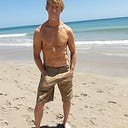A Panacea For Bad Hips and Aging
Tom Furman
When we stood more as a society, the issues were different. We’d get a more extreme lumbar curve. Issues like, ‘lumbago’, were mentioned. Even Joseph Pilates taught endless crunching type motions and forward bending to counteract this. [Quite aggressively I might add, if you have seen a video of him with a client.] Now we sit. We sit a lot. We look at television, computer monitors and phones. This inactivity is enough to cause atrophy and disuse, however the seated position is also like putting the body in cast. The cast keeps us in compromised alignment. It is aging.
There is a fix for this. It’s called exercise. Movement and activity done with a plan in mind can be a game changer. No amount of food supplements or pharmaceuticals or dieting will change your age related adaptation to sitting 8–12 hours per day. You must move.
People who enjoy exercise often do too much. The very culture of gym life or outdoor activity is highly enjoyable and can also distract us from life’s stress. On the other hand, there are those that struggle just to make it through the day. They are too tired to exercise and consider it pointless. They think age related loss of function is just a part of getting older.
I’m offering an exercise that can breath life back into your body. It’s called the Kettlebell Windmill. While no, one, exercise can fix everything, the Windmill covers a lot of real estate. You get lots of bang for your buck.
If you have never seen a Kettlebell Windmill, the closest description is that it looks somewhat like a Yoga Triangle pose, but different. A Kettlebell is held in the overhead hand and the body is hinged at the hips. The stress is greater on one side of the body. This movement is about a strong, healthy, range of motion. Some turn it into a strength feat to boost their social media accounts. However doing it with too much weight will cause excessive bracing and limit the healthy and safe, range of motion. As well this is not a particularly hypertrophic [muscle size building] exercise, however the upper back, hip, glutes and hamstrings will be loaded with ample time under tension.
There is a sequence to learning this drill. Some progressions are faster and some are slower. However to coax improvements in muscle tissue to include strength and range of motion, a very organized, step by step process is needed. As well, connective tissue develops very slowly. As Celebrity and Sport Trainer, Gunnar Peterson says, “Develop the movement, develop the joint, develop the muscle.”
The muscles of the hip, abdominals and legs are complex. Sitting is simple. It shortens, it weakens and it stiffens. Loading the muscles through a full range of motion and moving slowly can start moving you in the right direction.
If you notice the form of a well done Windmill, you can see the hip muscles under load in a stretched position. As well, the torso and core are stabilized and the shoulder and thoracic spine are loaded and contributing the the movement. Even the grip, biceps, lats, quads and calves are doing work.
Those who have not resistance trained or who avoid physical activities will often view any form of lifting or strength work as, “bad for the back.” However the, “hinging motion”, is perhaps the most powerful movement the human body can do. The current deadlift record is over 1000 pounds.
I think the most gradual approach is best. In fact you may be accomplished at the Windmill, but going through these earlier steps can help you find weak and tight areas that need addressed.
- Kneeling with NO weight.
- Palm to Ground.
- Elbow To Ground. [This is required for 3–5 repetitions and 3–5 sets before going to the next step.] https://youtu.be/uJvyRwHdFsg
2. Kneeling with weight. Repeating the above with a load. Both Palm and Elbow.
3. Standing NO weight.
4. Standing, weight in lower hand.
5. Standing, weight in upper hand. https://youtu.be/AIHPe39C4Bo
6. Standing, weight in both hands. https://youtu.be/vkG8Jedmkds
7. Variation: Stiff Legged. https://youtu.be/owvDVfY00sI
8. Variation: KB Armbar to Turkish Get Up to Windmill. https://youtu.be/whG8-6kfPkY
Your workout is composed of slow, low, reps and sets. This not to be done explosively. Loading the joints and connective tissue properly is as, if not more, important than developing the muscle. Windmills should be done 3 days per week. If you are, ‘ungluing’ years of abuse and tightness, it is imperative that you adopt a slow, patient, approach to rebuilding and increased mobility. For this reason, do 3–5 sets of 3–5 reps.
A fantastic article on the nitty, gritty, details of the Windmill has been written by Brett Jones. Click the link. https://www.strongfirst.com/kettlebell-windmill-101/
So while the statement that, “sitting is the new smoking”, may be valid, here is at least, part of the fix. #trainforlife
